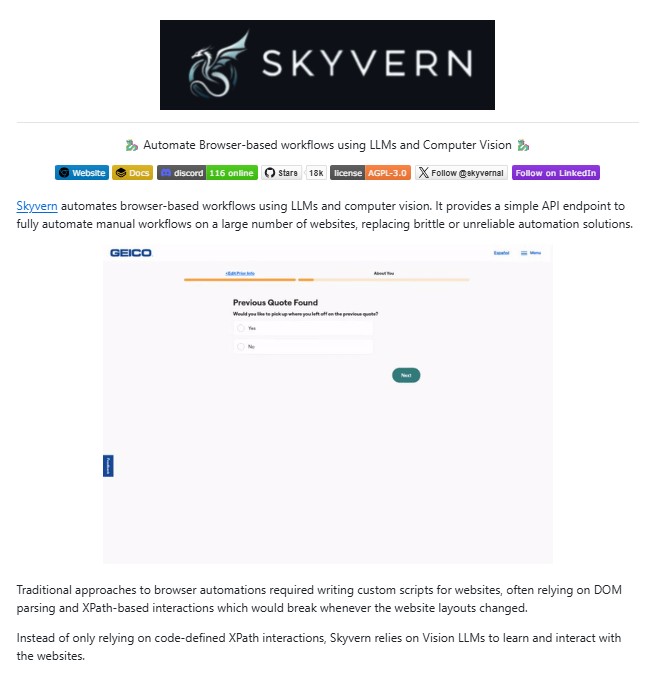In today’s fast-evolving digital landscape, automation plays a crucial role in enhancing productivity, efficiency and innovation. Yet, traditional browser automation tools often struggle with complexity, maintenance and reliability. They rely heavily on DOM parsing, XPaths and rigid scripts that easily break when websites change their layout.

Enter Skyvern, an open-source, AI-driven browser automation platform developed by Skyvern-AI. Unlike conventional tools, it leverages Large Language Models (LLMs) and computer vision to understand and interact with websites the way humans do. It transforms the way developers, researchers and enterprises automate workflows offering a blend of intelligence, adaptability, and simplicity.
What Is Skyvern?
It is a groundbreaking browser automation framework that enables users to automate manual web-based workflows using AI and computer vision. It replaces the need for brittle scripts and XPaths with intelligent vision-driven understanding, making automation far more resilient and flexible.
Instead of relying on fixed rules, Skyvern empowers AI agents to perceive, plan and execute tasks on any website, regardless of its structure or language. From filling out forms and logging in to extracting data and downloading files, Skyvern can navigate complex web environments without human intervention.
Its architecture combines LLMs, computer vision, and browser automation tools like Playwright to perform real-time reasoning and visual mapping of web elements allowing it to automate workflows across a large number of websites with high accuracy.
How Skyvern Works
It takes inspiration from autonomous agent architectures like BabyAGI and AutoGPT but enhances them with vision-based interaction.
The system operates through a swarm of AI agents that collectively understand a webpage, plan actions and execute them step by step. These agents use LLMs to reason about content and computer vision to identify and interact with elements like buttons, inputs and links.
This multi-agent approach has several unique advantages:
- Adaptability: Skyvern can operate on websites it has never encountered before.
- Resilience: It remains unaffected by minor UI changes since it doesn’t depend on static selectors or XPaths.
- Scalability: A single workflow can be applied to multiple websites with minimal reconfiguration.
- Contextual Reasoning: Skyvern’s LLMs can infer missing information or logical connections that a rule-based system would miss.
For example, when retrieving an insurance quote, Skyvern can infer that if a user received their driver’s license at age 16, they were eligible to drive at 18 even if the exact information isn’t directly provided.
This kind of semantic reasoning sets Skyvern apart from conventional RPA tools.
Key Features
1. AI-Powered Task Execution
Tasks in Skyvern represent individual automation goals such as filling out forms, downloading files or scraping data. Each task includes a URL, a prompt and an optional schema defining the structure of the output.
2. Workflows
It allows users to chain multiple tasks together to create complete workflows. This means you can automate multi-step processes such as purchasing products, downloading invoices or submitting applications.
Workflows support:
- Browser actions
- Data extraction and validation
- For loops and conditionals (coming soon)
- HTTP requests and custom code blocks
- Email and file operations
3. Vision-Based Automation
By using computer vision, Skyvern understands web interfaces visually. It recognizes forms, buttons, tables and inputs by how they appear on the screen, just as a human would. This makes it layout-agnostic and highly reliable.
4. Form Filling and Data Extraction
It can automatically fill forms, extract structured data and even conform its output to predefined schemas in JSON format. This makes it powerful for business process automation and analytics workflows.
5. File Downloading and Storage
Files downloaded through Skyvern are automatically uploaded to block storage allowing seamless data management and retrieval.
6. Authentication and 2FA Support
It simplifies automating workflows behind login screens by supporting various authentication methods including QR-based, email-based and SMS-based two-factor authentication (2FA).
It also integrates directly with password managers like Bitwarden, 1Password and LastPass ensuring security and convenience.
7. Integration and Extensibility
It supports integration with popular workflow tools such as Zapier, Make.com and N8N enabling smooth connectivity between Skyvern and enterprise applications.
It also implements the Model Context Protocol (MCP), allowing developers to connect any LLM that supports this standard including OpenAI, Anthropic, Gemini, Azure OpenAI and Ollama.
8. Real-Time Livestreaming
Developers can livestream the browser viewport to observe what Skyvern is doing in real time. This feature helps with debugging and provides transparency when automating complex workflows.
Skyvern Cloud and Local Deployment
It offers both self-hosted and managed cloud versions:
- Skyvern Cloud is a fully managed solution with built-in proxy networks, CAPTCHA solvers and anti-bot mechanisms. It allows users to run multiple Skyvern instances in parallel without handling infrastructure.
- Local Deployment is ideal for developers who prefer self-hosting. It can be set up easily using Docker Compose and includes a visual UI available at http://localhost:8080.
Skyvern supports Python SDK integration allowing developers to trigger and manage tasks directly through code.
Example:
from skyvern import Skyvern skyvern = Skyvern() task = await skyvern.run_task(prompt="Find the top post on Hacker News today") print(task)
This simplicity enables seamless integration into AI pipelines or backend automation systems.
Performance and Evaluation
It demonstrates state-of-the-art (SOTA) performance on the WebBench benchmark achieving a 64.4% accuracy rate. It performs particularly well on WRITE tasks such as form submissions and file downloads which are vital for RPA (Robotic Process Automation) use cases.
Its ability to handle complex reasoning and dynamic layouts makes it a preferred choice over rule-based automation frameworks.
Future Roadmap
Skyvern’s development roadmap is ambitious and community-driven. Upcoming features include:
- A visual workflow builder for drag-and-drop automation design
- Prompt caching to reduce LLM costs and improve speed
- Improved context understanding for more accurate interactions
- Chrome extension for quick automation recording
- LangChain integration for advanced AI workflow orchestration
These additions will further strengthen Skyvern’s position as a next-generation automation framework.
Conclusion
It represents a major leap forward in browser-based automation. By combining LLMs, computer vision and intelligent agents, it offers a level of adaptability and reliability that traditional automation frameworks can’t match.
Whether you’re automating repetitive business processes, conducting research or building intelligent AI agents, Skyvern delivers a powerful and flexible platform to accomplish your goals efficiently.
Its open-source foundation, growing community, and support for leading AI models make it a vital tool for anyone looking to push the boundaries of automation in 2025 and beyond.
Follow us for cutting-edge updates in AI & explore the world of LLMs, deep learning, NLP and AI agents with us.
Related Reads
- Steel Browser: The Open-Source Browser API Powering AI Agents and Automation
- Bytebot: The Future of AI Desktop Automation
- Claude-Flow v2.7: The Next Generation of Enterprise AI Orchestration
- Nanobrowser: The Open-Source AI Web Automation Tool Changing How We Browse
- Plandex AI: The Future of Autonomous Coding Agents for Large-Scale Development
